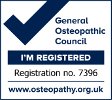Avoiding aches and pains - correct bike set-up
The success of the British team in the London Olympics and the Glasgow Commonwealth Games have led to a surge in bike use. We Osteopaths love this and always encourage our patients to increase their activity levels, however correct bike set up is key not only in improving comfort levels but also preventing injury. Cycling on a badly set up bike can result in injury a great deal of force is transferred through the lower extremities with a lot of repetition. The knee joint is particularly likely to be injured given the high loads put through it when cycling.
Lower limb injuries are commonly related to the saddle being set up too high or too low while back and neck problems are often linked to inappropriate frame size or the handle bars being an incorrect distance from the saddle.
Here are some tips that may help you avoid injury:
- Avoid over-reaching to the handle bars – move your saddle forward if possible or, even better, the handle bars back
- Ensure your saddle is at the correct height. Support yourself against a wall or similar and put the ball of your foot on the peddle with the peddle at it lowest point in the cycle (near the ground). Your knee should be slightly bent at the correct height. Adjust as necessary and do the same on the other side.
- Clipping in or using cleats? Make sure your foot is positioned centrally on the cleat avoiding having your feet in a pigeon toed or penguin position
- Keep your saddle in a neutral position with no tilt – particularly to avoid problems in the genital area
- Finally make sure that you are comfortable on the bike, keeping your shoulders relaxed where possible and trying not to grip too hard with your hands while you are cycling. If you do need to adjust your bike, try and change one thing at a time. If all this seems like to much to think about, take your bike along to a good bike shop and ask them to set you up.







